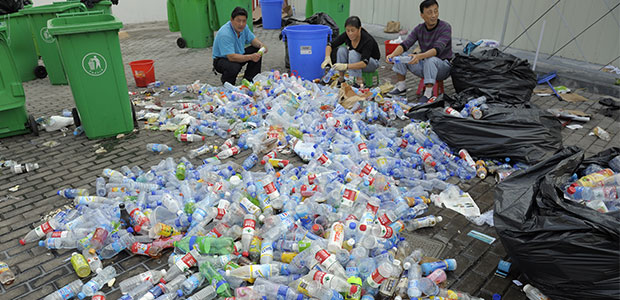
People Think China Ruined US Recycling, but It’s a US-Rooted Problem
Here’s how recycling has changed in all 50 states since changes in China’s waste import laws—and what we should do about it.
There’s a lot of confusion about the state of the United States’ recycling systems, and with good reason. Do things actually get recycled? What does China have to do with our recycling systems? Well, we have some answers.
In order to understand how the U.S. recycling system works, it’s important to understand the role other countries—namely China—play, too. The whole thing is more complicated than people think.
One article from The Hill gives a comprehensive look at the background. In early 2018, China banned many scrap materials and decided not to accept others unless they meet an extremely low contamination rate of 0.5 percent.
This was a problem for the United States. Not only has the United States relied on foreign markets to process most of its recyclables, but most of the time, US recyclables reach a 25 percent contamination rate or higher in many parts of the country.
After China changed its laws in 2018, materials from the US, UK, and Australia began flooding ports in countries like Thailand, Vietnam and Malaysia, which then began to enact their own restrictions on waste imports.
The crisis is one that, when it comes down to it, is about US dependence on other markets to handle recyclable materials. When many countries that once handled US materials changed their policies, the US went into crisis mode and did not know what to do with its materials. For many cities, that mean actually throwing recycling materials away, or burning them.
Hundreds of US cities began scaling back or cancelling their recycling programs altogether. The fallout revealed the need for a larger domestic market for recyclables, and it also revealed the extent to which most Americans weren’t educated on how recycling works and what happens after a water bottle goes into the bin.
The problem is not just a lack of a domestic recycling market, however. The US has also failed to actually decrease its use of sustainable and eco-friendly materials. The domestic demand for plastic products has only increased.
Most cities in the US did not develop domestic systems for recyclable products. However, Montgomery County, Maryland did generate revenues from recycled materials and sold the majority of it domestically. This, say many, is truly the answer.
“China said no, and that’s really the right answer,” says Keefe Harrison, CEO of a national nonprofit called The Recycling Partnership. “The shift from China really shined the light on our bad practices for waste [in the U.S.] What is the cost of pivoting from a linear economy to a circular one? It’s tough love but it’s needed.”
How are US consumers expected to recycle now, then?
While the US attempts to adjust to this recycling crisis and dependence on foreign markets, there are ways the average consumer can recycle with purpose.
For one, in addition to providing monetary grants to towns and municipalities, you can do your research. The Recycling Partnership has been working with companies to ensure their sustainability pledges are upheld. The organization recognizes that companies are more likely to reach sustainability commitments when they receive sufficient expertise from partners and are held accountable.
For example, the Coca-Cola Company, Keurig Dr. Pepper and PepsiCo announced a partnership with the World Wildlife Fund, the Recycling Partnership and Closed Loop Partners for a program that will make sure plastic bottles are “recovered after use and remade into new bottles.”
HP Printing has long been committed to developing products using recycled and repurposed materials, and it is a leader in the printing and technology industry in how to have an eco-friendly business model.
And these are just two examples of businesses making effective change.
Second, you can understand how recycling works in your local area—by state or city. Each region of the country differs in how it treats recycling, and your area might not be as environmentally conscious as you think.
WasteDive provides a helpful webpage for determining how recycling works in each state, especially since about 60 curbside recycling programs have been cancelled around the country. The webpage goes in-depth about how each state is tackling—or not tackling—the recycling problem.
Carrie Katan, U.S. PIRG Education Fund’s Zero Waste program fellow and co-author of the PIRG report, said, “It’s past time to make sure that recycling, composting and waste reduction each play an important role in the fight against microplastic pollution, climate change and other environmental challenges.”
As Katan said, “It’s entirely within our power to fix the system.”